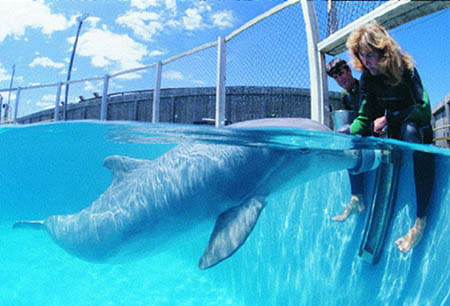Little is known about the physiology of cetaceans, the order of mammals that includes whales, dolphins, and porpoises. Even though these charismatic animals are tremendously popular with the public, scientists have remained in the dark about many aspects of cetacean life. Two male Atlantic bottle-nosed dolphins at UCSC's Long Marine Laboratory, however, are helping researchers there shed new light on the subject.
Just as a sports physiologist examines top athletes for clues to their performance edge, associate professor of biology Terrie Williams is studying the dolphins, Primo and Puka, in an effort to understand the intricacies of their physiology better. In the process, the metabolic and biomechanical data Williams is collecting is providing vital knowledge that may protect cetaceans from an uncertain future.
"This research is filling us in on the basic 'how-they-work' biology of dolphins, and it's also giving us a better understanding of what it takes for any mammal to make a living in the ocean," Williams says.
UCSC scientists have studied Primo and Puka since October 1994, when the dolphins began their residency at UCSC's marine facility, courtesy of a cooperative program that makes some of the U.S. Navy's trained dolphins available to civilian researchers. Williams's research, in fact, is primarily funded by the Office of Naval Research.

Primo, one of two resident dolphins at Long Marine Lab, swims against a force-measuring instrument, part of a setup that allows biologist Terrie Williams to measure the dolphin's metabolic rates during exercise. Head trainer Billy Hurley looks on as Williams encourages Primo by stroking his head. (Photo: Chuck Davis/Tidal Flats, Ltd.)
Williams and her team are paying particular attention to the various components of dolphin energetics--their exercise metabolism, temperature regulation, diet, and nutrition. "Once we understand the basic energetic needs of the animal, we can put the whole package together and say what a dolphin needs in its environment to survive," Williams says.
Armed with this knowledge, scientists will be in a better position to protect wild dolphins from the effects of human activities, notes LML's head dolphin trainer Billy Hurley. Coastal pollution, global warming, and competition from commercial fisheries are among the challenges facing wild dolphin populations. Natural phenomena such as El Niño can also alter their environment and change the distribution of the fish dolphins eat.
"Solid research is the only way to truly address conservation issues," Hurley maintains. "We have to know what they face in the wild in terms of energy requirements, food sources, and competition."
Competition from commercial fisheries, for example, has been implicated in the declines of many populations of marine mammals, such as Steller sea lions in parts of Alaska, Williams says. If scientists are to understand fully the degree to which dolphins can cope with such changes in prey populations, researchers must know how much energy the animals expend to pursue and capture food.
Likewise, understanding dolphins' ability to regulate their body temperature will indicate how much influence water temperature has on where they can live. Williams, for one, wonders whether changes in the geographic ranges of dolphins observed during El Niño conditions occur because they are following certain prey species or responding to water temperatures. Knowing the physiological limits of different species of cetaceans will help scientists understand the roles various environmental factors play in determining their ranges.
Williams has focused much of her research on the energetics of swimming, measuring the dolphins' metabolic rates during exercise and assessing the efficiency of their swimming strokes. For biomechanical analyses, Williams uses a digital video camera and computer software originally developed to help athletes improve their performance.
Training the dolphins to take part in these experiments was especially difficult, Hurley says. Each dolphin is trained to place its "nose" (actually its rostrum) into a cup and push on the cup by swimming in place (pictured above). A transducer behind the cup measures the force applied. While the dolphin swims in place, researchers monitor its heart rate and oxygen consumption. The experiment is the dolphin version of a treadmill workout.
The dolphins' participation in the experiments is voluntary, Hurley notes. "They can quit and swim away anytime they want. For this particular experiment I had to get them to do one behavior, swimming in place, for 20 minutes straight with no reward until the experiment was over."
Each time one of the dolphins completed the experiment, Hurley rewarded it with a lavish meal of fresh fish. For the researchers, meanwhile, the payoffs are valuable insights into dolphin energetics.
"The system measures how much force they're producing and how much energy it takes to create that force, while an underwater camera records what kind of swimming stroke they're using, so we can see what kind of stroke is most efficient," Williams says.
She and her research colleagues are building upon the information that Primo and Puka have provided, applying it to studies they are conducting of dolphins in the open ocean. Such ocean observations have taken Williams and her team to the Bahamas and San Diego, where they monitored the deep dives of trained dolphins and other marine mammals. And in a new project, Williams's team is working much closer to home--studying the physiology and behavior of wild dolphins in Monterey Bay.
--Tim Stephens